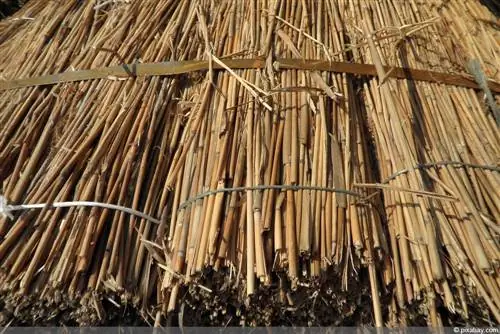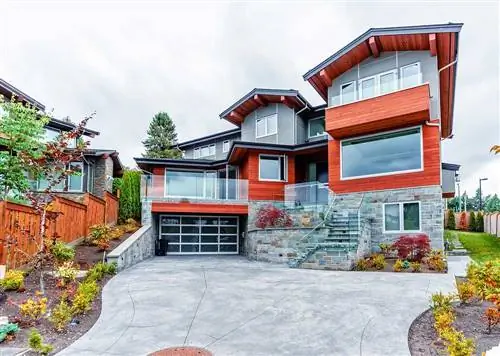- Author admin [email protected].
- Public 2023-12-17 03:39.
- Last modified 2025-01-24 12:45.
Not only are they practical and protect against wind and/or prying eyes from neighbors, but they also create an exotic ambience in gardens or on balconies. The attachment procedure depends on whether the privacy and wind protection is to be installed on a fence or railing from a balcony, or whether there is no background. Find out from the garden experts what you need for self-assembly and how to do it easily.
Preparation
Once the wind and privacy protection project has been decided, planning can begin. Before you go shopping, you should make a shopping list with everything you need in terms of materials and, if necessary, tools. Of course, it is important that you know what length and height your reed mat should be. There must also be a surface to which you can attach the mats. Accordingly, you should have the following information/answers:
- Reed mat dimensions
- Does it need to be shortened?
- Is there a background to attach or does one have to be made?
Tip:
Buy reed mats that are a little too high rather than too short. The height can then be shortened if necessary, but a height that is too low cannot be corrected.
Required materials
In order to be able to quickly assemble and attach reed mats in the garden or on the balcony, you should have all the materials and tools you need to hand before starting the self-assembly. The basic equipment includes:
- Reed mat of sufficient size according to the length and height to be covered
- Folding rule and pen if a mat needs to be shortened
- Combination pliers when using wire
- If necessary, side/cut-off grinder or hand-held circular saw
- Appropriate fastening materials depending on the surface
- Metal or wooden posts and a substructure if this is not available for fastening
Wooden background
If the reed mats are to be attached to a wooden surface such as a vine frame or wooden garden fence, the attachment is quick and easy with a stapler with stapler clamps.
Metal background

If attachment to a metal fence or metal posts is desired, mat ties must be purchased that are available for reed mats and can be selected with a plastic coating in the color of the mats. Alternatively, stainless steel wire is also suitable. Both are robust against rust. However, bare stainless steel wire is more noticeable on a small balcony because it can reflect, especially when exposed to sunlight. If there is a greater distance, such as on roof terraces or in the garden, they do not disrupt the decorative aspect. When making your selection, you should also not ignore the color of the surface. For example, if you want to attach the mats to a fence at the property boundary as a privacy screen, different colored ties/wires could have a negative impact on the appearance of the property.
Without fence or other background
If there is no background, create a device. The easiest way to do this is with so-called frame wood. This gives the reed mat sufficient stability after it has been attached and does not tip over or bend in strong winds. Alternatively, you can of course make a wooden frame yourself from conventional roof battens. To do this, you will also need wooden nails or wood screws as well as a hammer or screwdriver and a spirit level so that a straight line can be created.
The wooden frames must be attached to posts so that they stand firmly. These can be purchased at hardware stores as wooden or metal fence posts. The easiest way to insert the piles into the ground is to use ground impact sleeves. These are primarily suitable for soft floors and light loads. If you want to set them in concrete, you have to put cement and sand on your shopping list.
More hands
Theoretically, you can set up and attach the reed mats yourself. However, it is quicker and easier if you have help. Another pair of hands makes the job easier, especially when holding the mat while it is being attached. In this way you avoid tipping over and it is easier to align it straight.
Height adjustment
Before attaching, the height of the reed mat for wind or privacy protection must be corrected if it is too high. To do this, proceed as follows:
- Unroll the reed mat
- Measure the height using a ruler
- When taking measurements, consider a minimum distance of two centimeters from the floor surface
- Mark the desired height with a pen on the mat
- Cut the mat to the desired height using a side cutter/cutting cutter or a hand-held circular saw
Tip:
With a long reed mat, you can place several layers on top of each other and then cut them. This way you save yourself a lot of time and effort. But make sure that the tracks do not shift when cutting.
Length shortening
The reed mats are usually offered on rolls in certain lengths. Getting the exact length for your project is only possible in rare cases, so the length must be shortened. You can do this as follows:
- Roll out the mat over the entire area you want to cover with it
- Pay close attention to the ends on the right and left so as not to shorten too much
- Add about three centimeters
- Cut the binding threads to the desired length
- Take three to five stalks (approx. three centimeters) from the open binding
- Reed mat should now be the desired length
- Knot the binding threads on the mat again
Tip:
If the excess length is not very large, you can simply fold it backwards and do not have to resort to a cutting tool.
Attach reed mat to fence
With mat ties or stainless steel wire
In order to ensure sufficient stability of the reed mat when there is increased wind load, it is recommended to use at least nine mat ties or stainless steel wires per square meter for attaching it to a fence. Use the following instructions to attach your wind and/or privacy screen correctly:
- Place the beginning of the mat at the desired point and at least two centimeters above the surface of the earth
- If using coiled wire, cut individual pieces to approximately ten centimeters
- Pull the first tie/wire through the penultimate stalk and the background and fasten/close it there
- Align the reed mat straight (roll out long mats about a meter and align)
- If possible, do not use the cut edges for fastening after shortening
- After alignment, attach the additional mat ties/wires up to the end of the mat
- Make sure the ties/wires are evenly distributed
- Twist the wire together with combination pliers to close it
- Be sure to bend the wire ends inwards at the back so that no one can get hurt
Tip:
If you bend them into shape before inserting the ties/wires, the routing through the stalks will work better.
Attachment to wooden substrate
If you have a wooden hunter's fence, you can attach it as you would a mesh or lattice fence. Alternatively, it can be attached using a stapler and staples, as well as on any other wooden surface, such as climbing aids, frame timbers or wooden railings on the balcony.
The prerequisite, however, is that it is a relatively soft type of wood so that the clamps shoot in firmly and do not bend due to the hardness of the wood. Spruce, larch and pine wood are, among other things, soft types of wood that are suitable as a surface for stapling reed mats.
Post binding
Attachment to the posts is recommended. If the rods are metal, you can also use conventional cable ties instead of mat ties or wire. Run these through the stalks in the same way as previously described for attaching the fence.
Mounting quantity
At least 20 staples should be inserted per square meter. If the reed mat is to be attached to a very drafty location, more staples per square meter are advisable.
With a frame timber, a clamp must be placed every ten to 15 centimeters all around.






